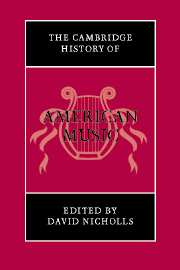Book contents
- Frontmatter
- PART ONE
- 1 American Indian musics, past and present
- 2 Music in America: an overview (part 1)
- 3 Secular music to 1800
- 4 Sacred music to 1800
- 5 African American music to 1900
- 6 Immigrant, folk, and regional musics in the nineteenth century
- 7 Nineteenth-century popular music
- 8 Art music from 1800 to 1860
- 9 Art music from 1860 to 1920
- PART TWO
- Bibliography and references
- Index
- References
6 - Immigrant, folk, and regional musics in the nineteenth century
from PART ONE
Published online by Cambridge University Press: 28 March 2008
- Frontmatter
- PART ONE
- 1 American Indian musics, past and present
- 2 Music in America: an overview (part 1)
- 3 Secular music to 1800
- 4 Sacred music to 1800
- 5 African American music to 1900
- 6 Immigrant, folk, and regional musics in the nineteenth century
- 7 Nineteenth-century popular music
- 8 Art music from 1800 to 1860
- 9 Art music from 1860 to 1920
- PART TWO
- Bibliography and references
- Index
- References
Summary
As the United States expanded in the nineteenth century its population increased dramatically. Much of that increase came from immigration, which was spurred by severe economic and political problems in parts of Europe. The overwhelming majority of immigrants to America still came from Europe in the nineteenth century, primarily from Germany, Ireland, and Great Britain. Only slightly fewer came from Scandinavia. On the West Coast there was considerable immigration from China. After 1880 Italian immigration began to rise, but the large waves of Italian, Russian, and Austro-Hungarian immigrants arrived only after 1900 (Thernstrom 1980, passim).
In this chapter I will discuss the kinds of music that the principal immigrant groups brought with them and the role immigrant musicians played in nineteenth-century American culture. I will not limit the discussion to new immigrants, however; I will also discuss the principal types of folk music that immigrants arriving before 1800 planted on American soil.
The subject matter presents immediate methodological problems, as much of the musical activity of immigrant groups was in the folk tradition. It was spontaneous and oral, leaving few documents. And though many of the traditions persisted into the twentieth century, they were not static. Thus to determine what nineteenth- as opposed to twentieth-century practice was can be elusive. In some areas documentation does exist. Collections of dances for the violin or flute almost certainly reflect folk practice, as do instrumental tutors, a particularly valuable source. Because of the tutors and many instrumental collections, we know more about nineteenth-century folk dance music than folksongs of several important ethnic groups.
- Type
- Chapter
- Information
- The Cambridge History of American Music , pp. 135 - 157Publisher: Cambridge University PressPrint publication year: 1998
References
- 1
- Cited by



